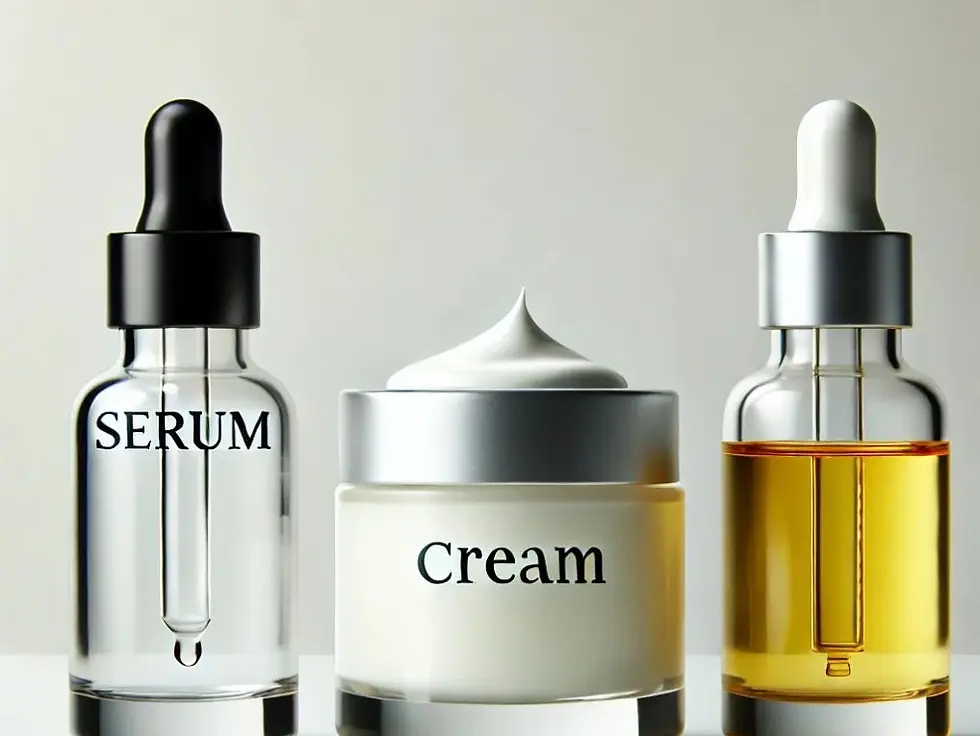Why Does Skin Change After Menopause ?
- Angéline Poulouin
- Jan 15
- 3 min read
Updated: May 24
Menopause marks a significant stage in a woman's life, bringing about hormonal changes that affect the body, including the skin. These changes are primarily linked to the decrease in estrogen and progesterone levels, two key hormones essential for maintaining skin health and youthfulness. Here is a detailed and scientific explanation of the mechanisms behind post-menopausal skin changes.
1. Decline in Estrogen: A Key Factor
Estrogen directly influences the structure and function of the skin. After menopause, its levels drop significantly, leading to several negative effects:
Reduction in Collagen Production: Estrogen stimulates collagen production, an essential protein that maintains the skin’s firmness and elasticity. After menopause, collagen synthesis decreases by 30% within the first five years, accelerating skin sagging and wrinkle formation.
Elastin Alteration: Elastin, another key protein for skin suppleness, becomes less functional and less abundant, contributing to a loss of elasticity.
Thinning of the Skin: The skin becomes thinner due to reduced keratinocyte (epidermal cell) proliferation and a decrease in dermal density, making it more vulnerable to injuries and external aggressors.
2. Increased Skin Dryness
Another major effect of menopause is heightened skin dryness, caused by several factors:
Reduction in Sebum Production: Estrogen regulates sebaceous gland activity, which produces sebum. After menopause, this production decreases, leading to drier, flakier skin.
Impaired Barrier Function: The skin’s lipid barrier, which retains hydration, becomes less effective. This results in increased transepidermal water loss (TEWL), leaving the skin dehydrated.
3. Changes in Pigmentation
Increase in Dark Spots:
Hormonal changes disrupt melanin regulation, the pigment responsible for skin coloration. This can lead to hyperpigmentation, particularly as dark spots or sunspots.
Uneven Skin Tone:
Irregular melanin production can also cause an uneven, dull complexion.
4. Loss of Firmness and Volume
After menopause, the skin loses volume and tone, mainly due to:
Thinning of the Hypodermis: The hypodermis, or fat layer beneath the skin, atrophies with age, reducing structural support and causing visible sagging, especially around the cheeks and jawline.
Loss of Hyaluronic Acid: Hyaluronic acid, a key molecule for hydration and skin structure, diminishes with the drop in estrogen, leading to volume loss and deeper wrinkles.
5. Increased Inflammation and Oxidative Stress
Menopause is also associated with heightened inflammation and oxidative stress in the skin:
Free Radicals: Lower estrogen levels reduce the skin’s natural antioxidant defenses, making it more vulnerable to damage from free radicals generated by UV exposure and pollution.
Chronic Inflammation: Hormonal decline can trigger low-grade chronic inflammation, contributing to collagen degradation and accelerating skin aging.
6. Increased Fragility and Delayed Wound Healing
With reduced estrogen:
Skin becomes thinner and more fragile, increasing the risk of injuries, redness, and irritation.
The skin’s ability to regenerate after injury is also impaired due to slower cell renewal.
Solutions to Counter Post-Menopausal Skin Changes
While these changes are inevitable, several strategies can help maintain skin health and appearance after menopause:
Intensive Hydration: Use products rich in hyaluronic acid, ceramides, and plant oils to strengthen the skin barrier and prevent dryness.
Sun Protection: Daily UV protection is essential to prevent worsening pigmentation and free radical damage.
Active Skincare: Incorporate products with retinol, peptides, and vitamin C to stimulate collagen, improve elasticity, and even out skin tone.
Professional Treatments: Dermatological treatments such as microneedling, fractional lasers, and hyaluronic acid injections can restore volume and stimulate skin regeneration.
Balanced Diet: Consume foods rich in antioxidants, omega-3s, and phytoestrogens (soy, flaxseeds) to support skin health from within.
These hormonal changes, while unavoidable, can be managed through targeted skincare, professional treatments, and a healthy lifestyle to maintain vibrant and youthful skin even after menopause.


.jpg)




Comments